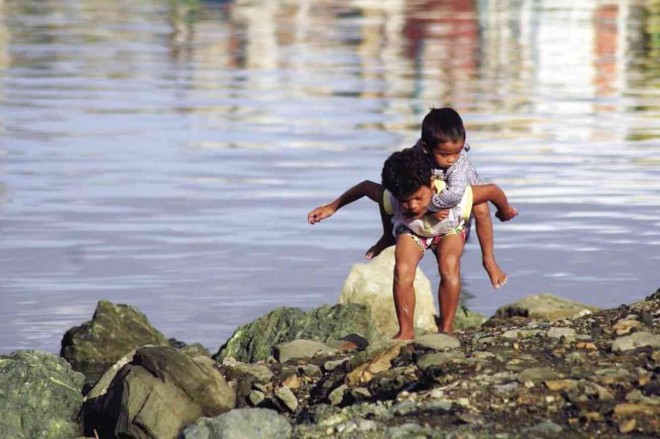
A CHILD carries another child on his back as they try to live normal lives in Tacloban City, now barely recognizable as the regional hub that it was before Supertyphoon “Yolanda” and an equally tragic government response struck. MARK ALVIC ESPLANA/INQUIRER SOUTHERN LUZON
TACLOBAN CITY—A woman picked up a gold Christmas garland from a mix of garbage at the fish port of this city.
She placed it around her neck and stared at the sea while grinning, unmindful of the heavy rain that soaked her hair on a Thursday afternoon.
Homeless residents staying in an abandoned building at the port of the city said it was their second time to see the woman, who could be between 30 and 35 years old.
The first time was two days after Supertyphoon “Yolanda” left their city in shambles.
They said she now wore a different set of clothes. This time, she wore denim pants and a green basketball jersey, with the words “Coast Guard Saving Lives” printed on it.
In both times, she was barefoot.
She looked as if she was saying something, but no one could understand what it was. She was clean but wet.
Along Maharlika Highway, another woman in her 20s was carrying a baby doll. Unmindful of her surroundings, she stared blankly at the doll she held in her arms.
In another area near the port, a group of children, around 2 to 3 years old, frantically cried in fear as heavy rains poured and thunder roared.
“The children have been traumatized not only by the downpour but by the sound and anything that would remind them of what they experienced with Supertyphoon Yolanda,” said fisherman Estorga Bantelan Jr., 83, at the seawall of this city.
Dr. Nathaniel Rempillo, Albay’s assistant provincial health officer and head of the humanitarian mission sent by Team Albay and Office of Civil Defense (OCD) Bicol, said these survivors of Yolanda were suffering from severe stress and trauma.
“They need immediate intervention,” he said.
As of Thursday, there were 25 persons at the evacuation center at Rizal Central School who have undergone counseling and stress debriefing from the staff of the Department of Social Welfare and Development (DSWD) Bicol who formed part of Team Albay-OCD Bicol.
“This kind of debriefing is being given to persons who have lost their family members or those whose relatives are still missing,” said Vilma Garcia, team leader of the DSWD group.
Rempillo said debriefing sessions would continue for as long as people need it.
He said they would also conduct debriefing sessions for children. Albay has one of the biggest filtration machines in Tacloban City now. It can filter 4,000 liters of water in one hour.
Rempillo said the water and sanitation filtration machine and water tank lorry had been able to distribute 164,200 liters of water to 16,430 families since it arrived on Nov. 11.
“As long as the machine is running, and we have fuel to run it, we will not stop providing clean water,” he said.
A total of 663 sacks and boxes of relief stocks and 260 boxes of mineral water have been transferred to the DSWD warehouse in Tacloban City.
The medical team has also addressed the needs of 2,777 persons at Tacloban City Health Office, Rizal Central School and Leyte National High School, Rempillo said.
A total of 128 bodies have been recovered by members of the Bureau of Fire Protection Special Rescue Unit, Naval Forces Southern Luzon and the Philippine Air Force.
There has been an improvement on how the city looks like after the typhoon but a lot still has to be done, said Rempillo.